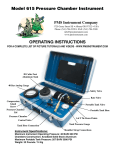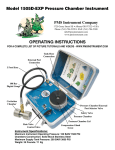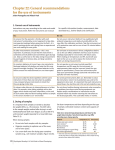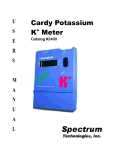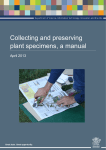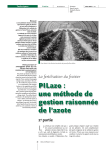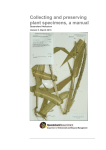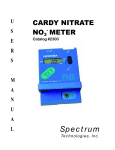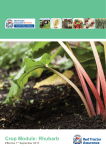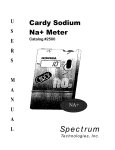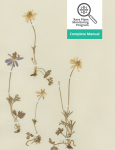Download PMS Model 670 Operating Instructions
Transcript
Model 670 Pressure Chamber Instrument PMS Instrument Company 1725 Geary Street SE ✦ Albany OR 97322 ✦ USA Phone: (541) 704-2299 ✦ FAX: (541) 704-2388 [email protected] www.pmsinstrument.com OPERATING INSTRUCTIONS For a complete list of picture tutorials and videos - www.pmsinstrument.com Safety Valve (not visible) Compression Gland Screw Gas Inlet (Tank Hose Connection) 40 Bar Analog Gauge Instrument Specifications: Maximum Instrument Operating Pressure: 40 BAR/ 600 PSI Chambers Construction: Anodized Solid Stock Aluminum Maximum Supply Tank Pressure: 200 BAR/ 3000 PSI Weight: 17 Pounds / 7.6 Kg Pressure Chamber Lid Pressure Chamber Control Valve Rate Valve 1 2 1) A lower canopy, shaded leaf is covered with foillaminate bag. 3 2) The water in the stem is under tension. 3) The stem is cut and the leaf with bag is sealed inside chamber. 4) Pressure is applied to the leaf until water appears at the cut surface. 4 How it Works Simply put, the pressure chamber is just a device for applying pressure to a leaf or small shoot. Most of the leaf is inside the chamber, but the cut end of the stem (the petiole) is exposed outside the chamber (see illustration above). The amount of pressure it takes to cause water to appear at the cut surface of the petiole tells you how much tension the leaf is experiencing on its water supply. A high value of pressure means a high value of tension and a high degree of water stress. These stress levels vary within different species. The unit of pressure most commonly used is Bar (1 Bar = 14.5 PSI). 2 What is Plant Moisture Stress? The water status of plants, and how to measure it, has received much attention in recent years and for good reason. Plant moisture stress (PMS), or plant water potential, indicates the demand for water within a plant. A PMS measurement indicates the water status of a plant from the “plant’s point of view.” PMS also tells how the environment affects the plant. High PMS levels cause many physiological processes, such as slowing or stopping photosynthesis. Conditions producing high PMS reduce plant growth and may eventually result in the death of the plant. PMS information can be used to evaluate the plants need for water or how well it is adapted to its environment. Why Measure Plant Moisture Stress? Measuring PMS gives an indication of a plants ability to grow and function and can be used as a guide for managing the plants moisture environment so as to improve growth and crop yield. Air temperature, wind speed, humidity, and soil moisture are all integrated by the plant into one single value — PMS. A measure of PMS thus gives an evaluation of the moisture status of a plant from the plants point of view. It is an excellent tool for aiding in irrigation scheduling for crop plants such as almond, walnut, prunes, cotton, and wine grapes or for any application where plant growth is managed such as in nurseries, greenhouses, seedlings or reforestation. Principle of Operation The pressure chamber can be thought of as measuring the “blood pressure” of the plant — except that for plants it is water rather than blood. And the water is not pumped by a heart using pressure, but rather pulled with a suction force as water evaporates from the leaves. Water within the plant mainly moves through very small inter-connected cells, collectively called xylem, which are essentially a network of pipes carrying water from the roots to the leaves. The water in the xylem is under tension. As the soil dries or humidity, wind or heat load increases, it becomes increasingly difficult for the roots to keep pace with evaporation from the leaves. This causes the tension to increase. Under these conditions you could say that the plant begins to experience “high blood pressure.” Since tension is measured, negative values are typically reported. An easy way to remember this is to think of water stress as a “deficit.” The more the stress the more the plant is experiencing a deficit of water. The scientific name given to this deficit is the “water potential” of the plant. The actual physics of how the water moves from the leaf is more complex than just “squeezing” water out of a leaf, or just bringing water back to where it was when the leaf was cut. However, in practice, the only important factor is for the operator to recognize when water just begins to appear at the cut end of the petiole. The Plant Moisture Stress (PMS) reading at any given time reflects the plant’s interaction with the water supply and the demand for water placed upon the plant by its environment (see diagram on back cover). Since these factors are almost always changing, PMS is nearly always changing. The time of measurement therefore requires careful consideration — PMS is most at midday and least just before sunrise. Pre-sunrise PMS values will usually reflect average soil moisture tension, if the soil is uniformly irrigated. Midday PMS values reflect the tension experienced by the plant as it pulls water from the soil to satisfy the water demand of the atmosphere. 3 GETTING STARTED 1. Attach the 6 foot hose to a nitrogen cylinder. Connect the other end of the hose to the instrument by retracting the quick-connect and insert the hose end. Ensure this is properly in place by tugging on the hose lightly. Maximum pressure in the cylinder should not exceed 200 Bar or 3000 PSI. The hose provided is US Standard (CGA-580). Check your local gas supply store for the proper sized connection if your local standards are not CGA-580. USING THE PRESSURE CHAMBER 1. Turn Control Valve on the instrument to the “OFF” position. 2. Slowly open the valve on the nitrogen tank. One-half to one turn is normally sufficient. CAUTION Do not uncouple the quick-disconnect fittings when hose is under pressure. Always check to see that the hose and instrument gauges indicate no pressure before operating quick-connect fitting. The purge valve on the 6 foot hose is used to release pressure from the hose. 3. Check the Safety Valve and Rate Valve using the following procedure. Remove the lid from the chamber by turning the lid counter-clockwise and lifting. Place a solid rubber stopper inside the recessed area under the lid as shown. Put the lid back on the chamber by pushing down and turning clock-wise to the stop. Lid must be turned completely to the stop to close the brass Safety Valve. If stainless steel piston is not depressed, chamber will not pressurize. This is a safety feature of the instrument to ensure lid is properly seated. 4 Turn control valve to CHAMBER position and pressurize the chamber. Adjust Rate Valve until pressure in the chamber increases at the desired rate. ½ Bar per second is a recommended rate of increase. Rate may be changed at any time, even while pressurizing a sample. CAUTION Do not close Rate Valve completely or use as a Shut-Off valve. Valve may be damaged as a result. 4. Turn the control valve to EXHAUST position to release pressure from the chamber. Remove the lid and solid rubber stopper from the inside of lid. You are now ready to take readings. 5. You can now select a leaf to test. To seal the sample, insert the cut end of the petiole (stem) through the hole from the bottom side of the chamber lid. Twist the Compression Screw clockwise to seal the sample in the lid. For more detailed information about sampling – consult our website. WHEN YOU HAVE COMPLETED MEASUREMENTS 1. Close valve on nitrogen tank. 2. Release pressure from 6 foot hose by using the purge valve on the hose. Release any excess pressure in chamber by turning control valve to EXHAUST position. 3. Check gauge on hose to ensure it indicates no pressure. Check gauge on instrument to ensure it indicates no pressure. Disconnect the hand nut from the nitrogen tank and then the quickdisconnect fitting on the instrument. 5 INSTRUMENT MAINTENANCE 1) Remove the O-Ring from around the lid. Clean with rag and lubricate with Petroleum Jelly for optimal performance. 2) Remove the Compression Gland Screw from the lid. Clean the threads of the Screw and the Compression Gland Base with a rag. Lubricate this with Lithium Grease (White Grease) for optimal performance. 3) Compression Gland Gasket can be cleaned with a rubber treatment such as used with automobile detailing (Armour All brand) for optimal performance. When Compression Gland Gasket becomes worn – replace with new gasket for optimal performance. CONTROL VALVE ADJUSTMENT The control valve will need periodic adjustment depending upon usage. Adjustment is required if leakage occurs in the pressurized instrument with the control valve in the OFF position. Two tools are needed and have been provided with your instrument. A 3/32 inch Allen Key is used to remove the Control Valve Handle. A 11/32 inch wrench is used to adjust the packing on the valve. 1. Pressurize the instrument with the control valve in the OFF position. 2. Loosen the hex screw with the Allen Key. It is located on the side of the Control Valve Handle. 3. Using the 11/32 wrench, slowly tighten the packing gland nut until the leak stops. CAUTION Do not overtighten the packing gland! Permanent damage to the valve will result. 4. Replace the handle and tighten the hex screw. For a complete list of picture tutorials and videos - www.pmsinstrument.com 6 Maintenance for Compression Gland Lid Maintaining the Compression Gland Lid is quite simple. Keep the O-ring around the Compression Gland Insert clean and lubricated with petroleum jelly. Occasionally unscrew the compression screw and take out the Compression Gland Insert and Compression Gland Gasket inside for cleaning. We recommend lubricating the compression screw threads with a Lithium based lubricant such as white grease or other lubricant to maintain the threads and ensure easy operation. Keeping these threads clean is important for ensuring operability of the cover. Clean the Compression Gland Gasket with ARMOR ALL or other similar cleaner. Over time the compression gland gasket will become worn, a replacement has been supplied for your convenience. If additional gaskets are needed, you may purchase them directly from PMS Instrument Company. Compression Gland Screw Chamber lid Friction washer (Red) 4 Buna 70 O-Rings (006) Compression Gland Insert Compression Gland Gasket Compression Gland Base 1 Buna 70 O-Ring (342) 4 Brass Screws To re-assemble the Compression Gland start by: 1. Sliding the Compression Gland into the Chamber Lid 2. Insert the 4 brass screws and screw the insert down tight — make sure that the 4 small O-rings are in place first 3. Put the Compression Gland Gasket into the Compression Gland Base 4. Put the Compression Gland Insert on top of the gasket and the Friction Washer on top of the Compression Gland Insert 5. Be sure to lubricate the threads and screw the Compression Screw into the Compression Gland Base 6. The Compression Gland Cover is now ready for use 7 Testing the Safety Valve The instrument is fitted with a Safety Valve to ensure that the lid is properly seated prior to pressurizing the chamber. The Safety Valve will vent the chamber if the lid is not properly closed. This valve MUST be tested at the beginning of each measurement session. 1 2 First, use your finger to depress the piston so that it is inside the safety valve Insert a solid rubber gasket into the lid 4 3 Turn the lid clockwise to the stop. Ensure the cam is directly over the piston Install the lid on the chamber 8 5 6 Then turn the lid back so that the cam is not blocking the piston Begin to slowly apply pressure to the chamber safety valve 7 Nut Collar Piston Buna 70 O-Ring (006) The safety valve should pop open before the pressure reaches 2 bar Elbow You will hear nitrogen escaping from the valve and the pressure will not increase in the chamber. If it does not, turn the control to EXHAUST, then remove the nut and piston of the safety valve and lubricate the O-ring on the piston with petroleum jelly. Reassemble and test the safety valve again. When the safety valve opens, the pressure in the chamber should drop to near zero. This time the safety valve should open at a pressure below 2 bar. If it does not, remove the nut and piston of the safety valve and again clean and lubricate the O-ring on the piston with petroleum jelly. Check for any foreign debris then reassemble and test the safety valve again. The safety valve is an important safety component of the instrument. Do not attempt to operate the instrument until the safety valve is operating properly; that is, until it is releasing the chamber pressure at less than 2 bar pressure, As an added safety precaution, the cover should be left in only one of two positions: 1. On the chamber and completely locked in place; or 2. Completely removed from the chamber. The lid should never be left in any intermediate position. 9 Warnings, Considerations and Limits Intended Usage The Pressure Chamber Instrument usage is intended for applying pressure to plant material to determine water potential or to extract water xylem from plants. It should not be used to pressurize anything other than plant material. Using this instrument for any other purpose or in an unsafe manner could result in harm to the user. Upon receiving the instrument or using it for the first time, each user should familiarize themselves thoroughly with all safety features and set-up process to avoid damage of instrument or physical injury to operator. Working Environment The instrument is robust and durable and designed for outdoor use. It may be used in temperatures as high as 55º C and as low as –10º C. It is best to store inside where temperatures do not exceed 40º C or lower than 0º C. Keep in clean and dry area. Store on a flat surface that is protected from being struck or damaged. Normal vibration during use will not affect performance of the instrument such as travel in vehicle or all terrain vehicles. Excessive shaking and vibration can cause damage. If the instrument has received a hard blow or hit, it should be evaluated prior to further use. The instrument is not vulnerable to humidity but should never be submersed in water. If the instrument becomes submersed, allow it to dry and evaluate the instrument prior to further use. Transporting Instrument Transporting the instrument by any mode should be done with care as not to strike the instrument against anything hard as this might damage the instrument. If transporting by vehicle such as truck, car or all terrain vehicle; the instrument should be securely fastened in order to avoid any damage to the instrument. Maintenance Most maintenance issues can be done without much training. Consult the maintenance pages in this manual. However, any adjustments to piping or high pressure connectors should only be performed by factory or authorized personnel. Consult us directly for more information. Disposal or Decommission of the Instrument While the instrument should provide years of use, it is possible that sometime it will be disposed of. Local recycling guidelines should be followed for disposal. 10 PMS Instrument Company 1725 Geary Street SE ✦ Albany OR 97322 Phone: (541) 704-2299 FAX: (541) 704-2388 E-mail: [email protected] www.pmsinstrument.com EU Declaration of Conformity We, PMS Instrument Company 1725 Geary Street SE Albany, OR 97322 USA Declare under our sole responsibility that the following products: 670 Pressure Chamber and 675 Pressure Chamber In addition, the following accessories are included: Super Chamber 2.5" x 12" Deep, Super Chamber 2.5" x 18" Deep, Super Chamber 2.5" x 24" Deep, Super Chamber 24.0" x 12" Deep, Super Chamber 4.0" x 18" Deep, Super Chamber 24.0" x 24" Deep, Super Chamber To which this declaration relates is in conformity with the following Standards or other normative documents: EN ISO 12100-1:2003, EN ISO 12100-2:2003, 97/37/EC Annex I Following the provisions of Directives; 98/37/EC, 97/37/EC (Equipment is below class I limits per the PED) Responsible party in the European Union: Place: Elancourt, France Date: May 6, 2009 President, PMS Instrument Company: Place: Albany, Oregon, USA Date: May 6, 2009 11 Atmospheric Demands: The atmosphere of the plant puts four different demands on the plant: wind, humidity, air temperature, and radiation. Plant Regulation: The plant regulates water stress by opening and closing the stomata (small holes) on the backside of the leaf. Other regulators used are leaf flagging, rolling and leaf loss. Good root development is also key in regulating water stress. Soil Supply: Soil composition is critical for the plant. Moisture content is a key factor in PMS. In addition, the temperature of the soil and depth will influence PMS. Depending upon the texture of the soil and how it holds moisture is another important aspect of the soil. Loose sandy soil will drain out moisture quickly while heavy clay will hold moisture longer.












